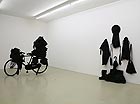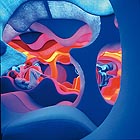
translated and summarized by: Liz Wollner-Grandville,
English summary December 15 - 21
Fondation Beyeler: Venice – From Canaletto and Turner to Monet
See Venice and paint
„Too beautiful to be painted“ was – according to his wife - Claude Monet’s reaction when he first saw the splendour of the Serenissima in 1908. Nevertheless he painted the beautiful city. In many letters Alice Monet reported that her husband attempted to catch the stunning Venetian light by painting the Serenissima innumerably at different times of day. Nonetheless, these paintings are not among his best.
„Venice – From Canaletto and Turner to Monet“ - a title one could have easily given to one of those blockbuster exhibitions in Vienna - is currently presented at the Fondation Beyeler in Riehen near Basel.
William Turner visited Venice long before it was discovered by mass tourism - he was there for the first time in 1819. Initially Turner was influenced by Canaletto’s classic Venetian veduta style, but during the following 25 years his views of Venice increasingly immersed into the Laguna’s ambient fog.
The highlights of this exhibit are not so much comprised of Monet’s, Renoir’s or Signac’s, but rather of graphic works and historic photographs. It is more the pastels and etchings by James McNeill Whistler or John Singer Sargent’s aquarelles that impress the viewers and mediate what Venice is all about.
The precise imagery and the usage of the triad black, white, and a powerful blue marvellously encapsulate Venice in two of Edouard Manet’s paintings, which he created during his stay in 1874. Everything else comes across like picturesque wallpaper.
Daniela Gregori
Fondation Beyeler
4125 Riehen/Basel, Baselstr. 101, until 25.01.09
www.beyeler.com
Krinzinger Projekte: Sakshi Gupta, Zakkir Hussain, Srinivasa Prasad, Navin Thomas, Avinash Veeraraghavan
On the poetry of a cloth bicycle
One must applaud the fact that this exhibition does not claim to show an overview over the art scene of the six million-city Bangalore. In the past years, many galleries ran into trouble because they promised to present a general overview – a promise they were of course unable to keep. Not so at Krinzinger Projekte. The show is a cooperation between the SKE Gallery in Bangalore and presents five current positions, clearly separated and without any reference whatsoever regarding the „Indian“ aspect of this art.
The highlight of the exhibition evolves around Srinivasa Prasad’s objects, which are completely covered by brown jute sacks and arranged in ensembles and sculptures. The well-known image in Indian streets of a fully laden bicycle, artistically covered with jute enfolds a wonderful kind of poetry. These familiar objects develop an aura of saintliness, invoke associations of wanderings and an impoverished life, and tell more about life than many other legends.
Avinash Veeraraghavan creates an eerie and nightmarish atmosphere in the gallery’s cellar. The completely abstract film – solely showing shadows and silhouettes accompanied by the sounds of laughing, crying or moaning as well as a few piano tones by Bach - is mesmerising.
The works by Zakkir Hussain, Navin Thomas and Sakshi Gupta are, in comparison, much less convincing. They lack what Prasad and Veeraraghavan are so impressively capable of: creating a very special atmosphere.
Wolfgang Pichler
Krinzinger Projekte
1070 Vienna, Schottenfeldgasse 45, until 10.01.09
www.galerie-krinzinger.at/projekte
Kunstmuseum Wolfsburg: Interieur/Exterieur: Living in Art. From Romantic Interior Painting to the Home Design of the Future
Cocooning with Friedrich
An entire cultural history ranging from art to design is presented here – and the list of renowned artists is long: John M. Armleder, Richard Artschwager, Francis Bacon, Miriam Bäckström, Carl Blechen, Etienne-Louis Boullée, Marcel Breuer, Thomas Demand, Eric Fischl, Sylvie Fleury, Caspar David Friedrich or Dan Graham – just to name a few. Works by about 70 artists and designers are shown – including romantic painters as well as Bauhaus architects and postmodern designers.
The exhibition deals with the interaction between design and art and attempts to create new constellations. Works by Henry van de Velde and Henri Matisse, Ludwig Mies van der Rohe and Tobias Rehberger are juxtaposed: these combinations are proof of the curators lust and joy to experiment and surprise. Paintings, sculptures, furniture, installation art, photography, and videos – 140 works are shown at the „Interieur/Exterieur“ exhibit, among them provocative creations such as the photo series „Saturday Night“ by In Sook Kim. Kim made the unscrupulous exhibitionism of our time a subject of discussion by shooting night pictures of an apartment house and its inhabitants.
Caspar David Friedrich’s „Bohemian Landscape with the Milesovka“ (1808) is also among the works shown, as are paintings by artists of the Biedermaier, who have nearly fallen into oblivion, and whose paintings are the early bourgeois form of what one would today call „cocooning“. One can marvel at a reconstruction of Mies van der Rohe’s Barcelona-Pavilion or Piet Mondrian’s Paris based studio, exquisite Jugendstil pieces, Californian architectural photography by Julius Shulman, as well as Interieur-paintings by the symbolist Edvard Munch and Félix Vallotton or a fantastic, completely vitrified living capsule by Werner Sobek.
At one time the eyes wander from the cosy home towards the outside, then again towards the inside with a longing for protection. Living may connote an option for retreat or it can be a media for representation. In any case – living means life, and life equals infinite desire – something Verner Panton’s walk-in living cage „Visiona 2“ attempts to show. A ramble through 250 years of living- and art history.
Marc Peschke
Kunstmuseum Wolfsburg
38440 Wolfsburg, Porschestrasse 53, until 13. 04.09
www.kunstmuseum-wolfsburg.de
Galerie Krinzinger: Bjarne Melgaard – Chickenhawk
Bittersweet retort blood
The total value of all the pieces shown at this exhibit amounts to nearly 1.25 million euro. Yes, good art is expensive, but it does not have to cost much. And the fact that rich artists with silver barbed wire jewellery are the favourite envied hate objects of a society, whose fear of poverty is suppressed, is not at all surprising. Is Mr. Melgaard’s sweat cheap enough?
Maybe Philip Guston, whose paintings these days are found on book covers, would have enjoyed the large-scale dialysis paintings. The integrated phalli come across as cute, and remind of the cutout heart form often found in wooden toilet doors. And there remains the sofa landscape as well as the smaller exhibition space, which is off premises for under-aged, showing a sequence of the German TV crime thriller series „Tatort“ (crime scene). The figurative phantom, whose stage seems to take place here, reminds of literary heroes such as Dorian Gray, American Psycho, Malina, and the German film Elementarteilchen. Numerous scalpels and scissors were scattered all over the place. Money was forgotten. Is this what outsourced nightmares look like? Does a good artist owe his audience a horror plot in 3D? Did the audience deserve the shock; wasn’t the stress in the traffic jam nasty enough?
It might be reconciling that the painter Bjarne Melgaard could find the nicer blood brothers in the art of painting.
Gesche Heumann
Galerie Krinzinger
1010 Vienna, Seilerstätte 16, until 16.01.09
www.galerie-krinzinger.at
Mehr Texte von translated and summarized by: Liz Wollner-Grandville


 Teilen
Teilen





